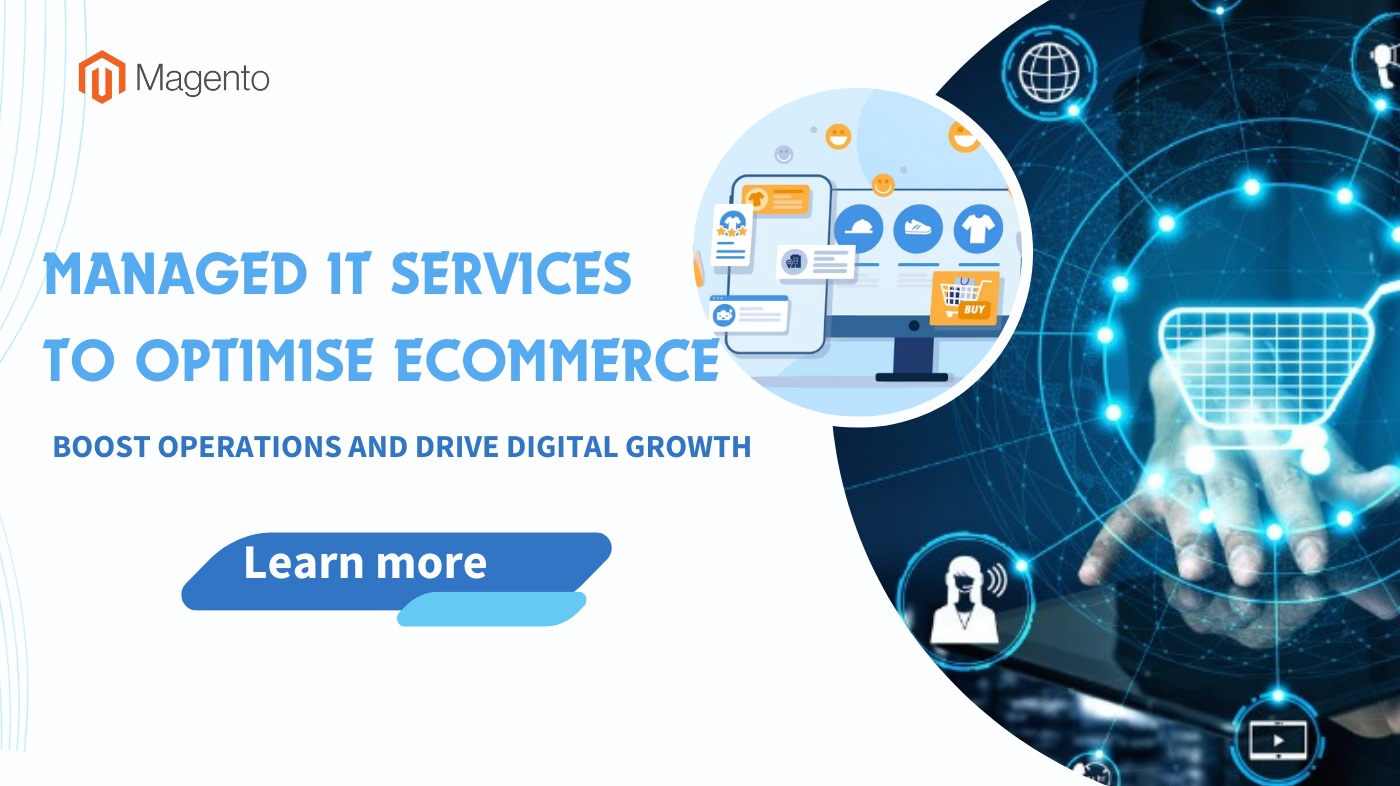
Managed IT Services to Optimise eCommerce are no longer optional. Slow sites, rising costs, and constant IT issues block digital growth. With the right managed IT services, eCommerce businesses can enhance cybersecurity, streamline operations, and focus on customers instead of troubleshooting.
Managed IT services, a trusted outside team that runs and improves your technology, can change that picture. You get experts across cloud services, cybersecurity, data analytics, and support. For eCommerce brands, this shift raises operational efficiency and fuels digital growth. The result is fewer distractions and more time for customers.
Big retailers use outside help for daily tasks and major projects. That mix keeps teams flexible and ready for spikes in demand. In this guide, you will see how managed services cut waste, sharpen workflows, and improve the customer experience. You will also get steps you can apply this quarter.
Table of Contents
I. Importance of Managed IT Services to Optimise eCommerce
Cyberattacks hit online stores every day. Cybersecurity means protecting systems, data, and payments from attackers. Managed IT teams put strong defenses in place and watch your systems at all hours.
Enhanced cybersecurity is not a luxury for online stores. It is a requirement. Outsourcing saves owners time so you can focus on revenue, not repairs.

Cloud computing uses internet-hosted servers instead of hardware in your office. It expands fast when traffic spikes during Black Friday or holidays. With expert support, your storefront stays fast instead of crashing when buyers rush in.
Process automation removes manual tasks that slow teams down. AI chatbots, simple software that answers questions using trained models, provide 24/7 customer help. Web analytics, the practice of tracking and studying site behavior, guides better marketing and higher repeat sales. These pieces work together and protect margins.
II. Enhancing Efficiency with Managed IT Services to Optimise eCommerce
Managed IT services raise operational efficiency across your store. Fewer manual steps mean fewer errors and faster handoffs. Clear workflows prevent rework and delays.
Improving workflows and processes
When you hand routine IT tasks to a partner, your time shifts to growth. Good workflow optimization, the disciplined way of mapping and improving steps, speeds daily operations and reduces risk.
- Outsource routine IT tasks to managed service providers so your staff can concentrate on increasing sales and improving customer relationships. Many Arlington companies like Tuminto have adopted this approach to keep internal teams focused on strategic growth instead of day-to-day troubleshooting.
- Move key processes like inventory tracking and order fulfillment into cloud solutions for greater reliability and instant access.
- Enforce strict cybersecurity protocols managed by experts who monitor systems 24/7, reducing the risk of data breaches that disrupt operations.
- Add AI-powered tools such as chatbots to your website; these tools handle repetitive customer support queries, reducing response times by half.
- Use analytics tools to measure the performance of every stage in your operation so you can identify inefficiencies quickly.
- Standardize workflows with automated alerts that remind your team of important tasks or deadlines, lowering human error rates.
- Integrate cross-platform IT support for real-time problem-solving, which minimizes downtime during peak shopping periods.
- Migrate to centralized data management platforms so your team experiences less confusion and reduces duplicate work across departments.

Automating routine tasks
Automation takes pressure off your team and frees up budget. Start with repeatable actions that follow clear rules. The gains appear within weeks.
- Automate inventory management with managed IT services to cut down on manual stock checks. This reduces errors and saves hours each week.
- Use process automation to handle order fulfillment, removing the need for employees to enter shipping details or send confirmation emails repeatedly.
- Integrate payment processing systems that automatically verify transactions, which lowers the chance of fraud and speeds up the checkout process.
- Apply workflow optimization tools to schedule routine updates and backups so your IT team can prioritize higher-level projects instead of tedious maintenance.
- Allow managed IT services to monitor systems around the clock; this detects issues before they impact customer orders or site performance. Providers offering solutions such as IT services by ISTT can help eCommerce businesses maintain optimal uptime and security through proactive monitoring.
- Shift routine system updates from in-house staff to automation, freeing up resources for business growth and advances in digital business initiatives.
- Rely on managed IT professionals for task improvement, cutting down redundant tools and subscriptions across your eCommerce solutions for better cost control.
- Prioritize automation in resource allocation, channeling staff energy towards improving operational efficiency rather than repetitive daily tasks.
- Reduce overhead costs by replacing manual routines with cloud-based efficiencies backed by reliable IT outsourcing partners.
- Improve customer experience as automated processes ensure real-time support responses while maintaining a smooth purchase journey every time.
III. Driving Digital Growth Through Managed IT Services to Optimise eCommerce
Technology integration links tools so that data flows cleanly. That lift supports digital growth and keeps decisions fast. Start with a clear map of systems and owners.
Using cloud computing for scalability
Cloud platforms scale resources up or down based on demand. During peak seasons, extra capacity keeps pages fast and carts stable. When traffic falls, you stop paying for unused servers.
Daily IT tasks move into managed cloud services, which gives you time for product work and marketing tests. Data analytics and simple AI models run in the cloud to personalize the storefront as demand grows. Built-in security controls protect sensitive data while you expand.
The payoff is steady performance with fewer outages. Your team focuses on clear goals instead of hardware tickets.

Using AI and machine learning for personalization
AI and machine learning are tools that learn from data to make predictions. In e-commerce, they study browsing and past orders. The result is product picks that match each shopper.
Recommendation engines can lift sales by double digits in many categories. AI chatbots answer common questions in real time and pass complex issues to people. That mix shortens queues and raises satisfaction.
Predictive analytics spots rising trends early. You can adjust pricing, inventory, or ad spend before rivals catch on. Customers feel understood, which builds loyalty and repeat orders.
IV. Improving Customer Experience
Customer experience is the sum of every touchpoint. Fast support, clear inventory, and secure checkout matter most. Managed services help each piece work together.
Implementing omnichannel strategies
Omnichannel means one connected journey across website, app, marketplace, and store. Shoppers switch channels and expect the same pricing, service, and tone. Managed IT teams handle the integrations and maintain security across all points.
Analytics reveal how people move across channels and where they drop off. Use those findings to improve journeys, not just single pages. During busy seasons, synced inventory and order data prevent oversells.
Work with your technology partners to align systems and rules. The result is higher conversion and fewer support tickets when demand surges.
Enabling real-time support and interaction
AI chatbots now provide round-the-clock help, on-site and in-app. Automated workflows route tickets, pull orders, and verify accounts in seconds. Managed IT services connect these tools so answers stay consistent everywhere.
Strong security protects payment and account changes as they happen. Cloud tools let service teams respond from any location with the same view of the customer. Faster, safer help brings shoppers back.
V. Cost Optimization with Managed IT Services
Managed services improve cost-effectiveness by trimming waste and focusing spend. You pay for results instead of hardware and guesswork. That discipline supports long-term digital growth.

Reducing IT infrastructure overhead
Outsourcing IT management cuts the need for large in-house setups. Providers monitor, patch, and improve systems at scale. Cloud services replace many physical servers, which lowers energy and maintenance bills.
Automation reduces routine labor hours across backups, updates, and checks. Pay-as-you-go pricing matches costs to actual use. Strong security controls also reduce the chance of a costly breach.
With fewer capital expenses, budgets shift to product, content, and customer care. That is where growth happens.
Eliminating redundant tools and subscriptions
Too many tools drain the budget and confuse teams. A steady audit process fixes that. Aim for fewer systems with higher adoption and better fit.
- Audit all software licenses across the business every quarter to find underutilized or duplicated tools.
- Review SaaS subscriptions monthly, focusing on those with low user activity to identify savings opportunities.
- Use license management platforms that help monitor active users per tool, preventing overlap and controlling budget.
- Consolidate similar subscriptions into multifunctional platforms to reduce wasted spending and unused features.
- Reduce IT infrastructure overhead by adopting cloud services that offer flexible usage-based pricing for storage, hosting, apps, and backup needs.
- Turn off old or infrequently accessed software after confirming data migration is complete to avoid unnecessary renewals.
- Set up automated alerts for upcoming software subscription renewals so teams can review actual needs before committing funds again.
- Assign an administrator from managed IT services to oversee subscription management, ensuring compliance while reducing the risk of redundancy.
- Use regular expense analysis reports to track trends in tool acquisition; this helps identify cost spikes from overlapping tools or seat licenses.
Clear tool ownership and short SOPs reduce confusion. Your staff knows where to work and which system is the source of truth.
Conclusion
Managed services help eCommerce teams cut waste, raise operational efficiency, and protect revenue. Cloud services, automation, and strong security keep the store fast and safe. Customers feel the difference through faster support and a smoother path to purchase.











![[SALE OFF] Discount 30% All Premium Extensions On Christmas And New Year 2025 christmas-and-new-year-2025](https://landofcoder.b-cdn.net/wp-content/uploads/2024/12/christmas-and-new-year-2025-1-218x150.png)






